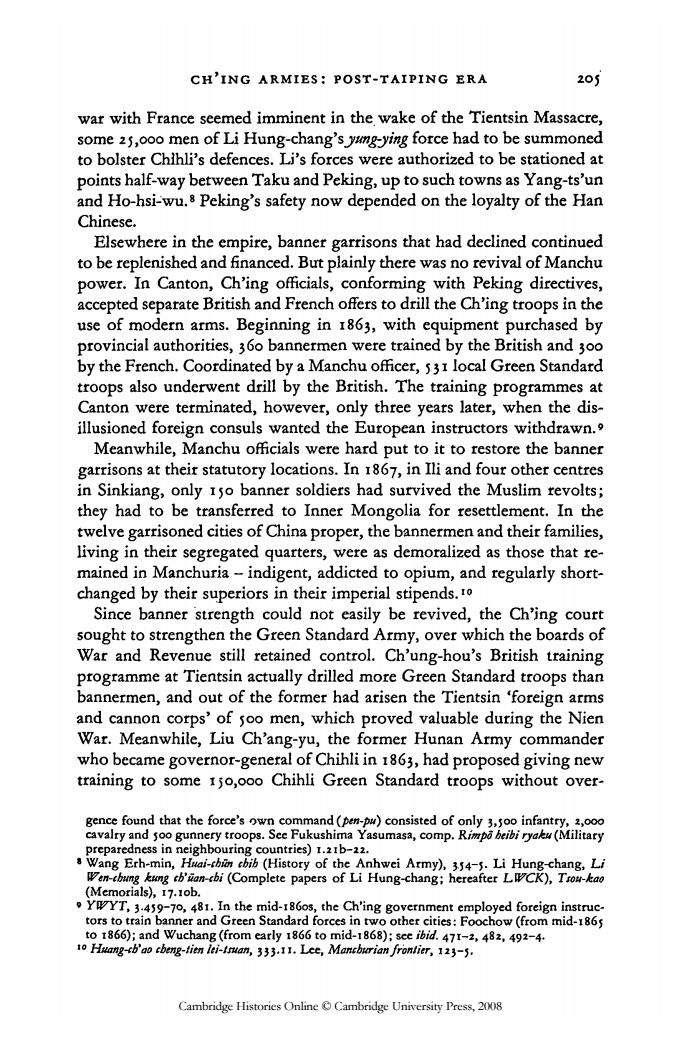正在加载图片...

CH'ING ARMIES:POST-TAIPING ERA 205 war with France seemed imminent in the wake of the Tientsin Massacre, some 25,ooo men of Li Hung-chang's yung-ying force had to be summoned to bolster Chihli's defences.Li's forces were authorized to be stationed at points half-way between Taku and Peking,up to such towns as Yang-ts'un and Ho-hsi-wu.8 Peking's safety now depended on the loyalty of the Han Chinese. Elsewhere in the empire,banner garrisons that had declined continued to be replenished and financed.But plainly there was no revival of Manchu power.In Canton,Ch'ing officials,conforming with Peking directives, accepted separate British and French offers to drill the Ch'ing troops in the use of modern arms.Beginning in 1863,with equipment purchased by provincial authorities,360 bannermen were trained by the British and 3oo by the French.Coordinated by a Manchu officer,53I local Green Standard troops also underwent drill by the British.The training programmes at Canton were terminated,however,only three years later,when the dis- illusioned foreign consuls wanted the European instructors withdrawn. Meanwhile,Manchu officials were hard put to it to restore the banner garrisons at their statutory locations.In 1867,in Ili and four other centres in Sinkiang,only Iso banner soldiers had survived the Muslim revolts; they had to be transferred to Inner Mongolia for resettlement.In the twelve garrisoned cities of China proper,the bannermen and their families, living in their segregated quarters,were as demoralized as those that re- mained in Manchuria-indigent,addicted to opium,and regularly short- changed by their superiors in their imperial stipends.1o Since banner strength could not easily be revived,the Ch'ing court sought to strengthen the Green Standard Army,over which the boards of War and Revenue still retained control.Ch'ung-hou's British training programme at Tientsin actually drilled more Green Standard troops than bannermen,and out of the former had arisen the Tientsin foreign arms and cannon corps'of soo men,which proved valuable during the Nien War.Meanwhile,Liu Ch'ang-yu,the former Hunan Army commander who became governor-general of Chihli in 1863,had proposed giving new training to some Iso,ooo Chihli Green Standard troops without over- gence found that the force's own command (pen-pw)consisted of only 3,5oo infantry,2,ooo cavalry and soo gunnery troops.See Fukushima Yasumasa,comp.Rimpo beibi ryaks (Military preparedness in neighbouring countries)I.21b-22. Wang Erh-min,Huai-cbin cbib (History of the Anhwei Army),354-5.Li Hung-chang,Li Wen-cbumg kung ch'ian-cbi(Complete papers of Li Hung-chang;hereafter LWCK),Trou-tao (Memorials),17.1ob. YWYT,3.459-70,481.In the mid-1860s,the Ch'ing government employed foreign instruc- tors to train banner and Green Standard forces in two other cities:Foochow (from mid-1865 to 1866);and Wuchang (from early 1866 to mid-1868);sce ibid.471-2,482,492-4. o Huang-cb'ao cbeng-tien lei-truan,333.11.Lee,Mancburian frontier,123-5. Cambridge Histories Online O Cambridge University Press,2008CH'IN G ARMIES: POST-TAIPING ERA 205 war with France seemed imminent in the wake of the Tientsin Massacre, some 25,000 men of Li Hung-ch&ng'sjung-jing force had to be summoned to bolster Chihli's defences. Li's forces were authorized to be stationed at points half-way between Taku and Peking, up to such towns as Yang-ts'un and Ho-hsi-wu.8 Peking's safety now depended on the loyalty of the Han Chinese. Elsewhere in the empire, banner garrisons that had declined continued to be replenished and financed. But plainly there was no revival of Manchu power. In Canton, Ch'ing officials, conforming with Peking directives, accepted separate British and French offers to drill the Ch'ing troops in the use of modern arms. Beginning in 1863, with equipment purchased by provincial authorities, 360 bannermen were trained by the British and 300 by the French. Coordinated by a Manchu officer, 531 local Green Standard troops also underwent drill by the British. The training programmes at Canton were terminated, however, only three years later, when the disillusioned foreign consuls wanted the European instructors withdrawn.9 Meanwhile, Manchu officials were hard put to it to restore the banner garrisons at their statutory locations. In 1867, in Hi and four other centres in Sinkiang, only 150 banner soldiers had survived the Muslim revolts; they had to be transferred to Inner Mongolia for resettlement. In the twelve garrisoned cities of China proper, the bannermen and their families, living in their segregated quarters, were as demoralized as those that remained in Manchuria - indigent, addicted to opium, and regularly shortchanged by their superiors in their imperial stipends.10 Since banner strength could not easily be revived, the Ch'jng court sought to strengthen the Green Standard Army, over which the boards of War and Revenue still retained control. Ch'ung-hou's British training programme at Tientsin actually drilled more Green Standard troops than bannermen, and out of the former had arisen the Tientsin 'foreign arms and cannon corps' of 500 men, which proved valuable during the Nien War. Meanwhile, Liu Ch'ang-yu, the former Hunan Army commander who became governor-general of Chihli in 1863, had proposed giving new training to some 150,000 Chihli Green Standard troops without overgence found that the force's own command (pen-pu) consisted of only 3,500 infantry, 2,000 cavalry and 500 gunnery troops. See Fukushima Yasumasa, comp. Rimpo heibi ryaku (Military preparedness in neighbouring countries) I.2ib-Z2. * Wang Erh-min, Huai-chiin Mb (History of the Anhwei Army), 5.54-5. Li Hung-chang, JL; Wen-cbung kung cb'uan-cbi (Complete papers of Li Hung-chang; hereafter L.WCK), Tsou-kao (Memorials), 17.10b. » YWYT, 3.459-70, 481. In the mid-i86os, the Ch'ing government employed foreign instructors to train banner and Green Standard forces in two other cities: Foochow (from mid-1865 to 1866); and Wuchang (from early 1866 to mid-1868); see ibid. 471-2, 482, 492-4. 10 Huang-tb'ao cbeng-ticn lei-ttuan, 333.11. Lee, Mancburianfrontier, 123-5. Cambridge Histories Online © Cambridge University Press, 2008